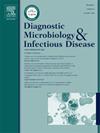Evaluation of an anti-HCV chemiluminescence assay: Enhancing diagnostic accuracy and reducing false positives in hepatitis C screening
IF 2.1
4区 医学
Q3 INFECTIOUS DISEASES
Diagnostic microbiology and infectious disease
Pub Date : 2025-04-03
DOI:10.1016/j.diagmicrobio.2025.116829
引用次数: 0
Abstract
Objectives
Detection of antibodies is recommended for the diagnosis and effective treatment of hepatitis C. This study evaluated the performance of a new chemiluminescence assay for detecting hepatitis C virus (HCV) antibodies and compared it with previous assays using a comprehensive set of routine and borderline samples.
Methods
A total of 2,216 serum samples were included in this study, comprising of 2,121 routine clinical samples and 95 borderline cases (COI range: 0.9-5.0). We compared the Anti-HCV-2 assay's (Mindray Diagnostics, Shenzhen, China) performance with the Anti-HCV-1 assay, assessing key parameters including sensitivity, specificity, positive predictive value (PPV), and negative predictive value (NPV). Precision was tested using replicate samples, and accuracy was validated through confirmatory RIBA (Mikrogen GmbH, Neuried, Germany) and Elecsys Anti-HCV assays (Roche Diagnostics, Mannheim, Germany). Interference testing was conducted to assess the assay's robustness against common substances found in clinical samples.
Results
The Anti-HCV-2 assay demonstrated high sensitivity (98.2 %), specificity (99.1 %), and accuracy (98.7 %) in routine clinical samples. For borderline cases, the accuracy of Anti-HCV-2 was significantly higher (96.84 %) compared to Anti-HCV-1 (3.16 %). Precision testing showed a coefficient of variation (CV) of <2 %, indicating excellent reproducibility. Anti-interference testing confirmed that the Anti-HCV-2 assay performed consistently across samples with common interferences, such as hemolysis and lipemia.
Conclusion
The Anti-HCV-2 assay outperforms the Anti-HCV-1 assay in terms of accuracy, reproducibility, and reliability, especially in the range of borderline, making it a valuable tool for routine HCV screening.
抗丙型肝炎病毒化学发光试验的评价:提高丙型肝炎筛查的诊断准确性和减少假阳性
目的:检测丙型肝炎抗体是诊断和有效治疗丙型肝炎的重要手段。本研究评价了一种新的化学发光法检测丙型肝炎病毒(HCV)抗体的性能,并将其与以往使用常规和边缘样本的检测方法进行了比较。方法共收集血清样本2216份,其中临床常规样本2121份,边缘病例95份(COI范围:0.9 ~ 5.0)。我们比较了Anti-HCV-2检测方法(迈瑞诊断公司,深圳,中国)与Anti-HCV-1检测方法的性能,评估了包括敏感性、特异性、阳性预测值(PPV)和阴性预测值(NPV)在内的关键参数。使用重复样品进行精度测试,并通过验证性RIBA (Mikrogen GmbH, Neuried, Germany)和Elecsys Anti-HCV检测(Roche Diagnostics, Mannheim, Germany)验证准确性。进行干扰测试以评估该测定法对临床样品中常见物质的稳健性。结果抗- hcv -2检测在常规临床样本中具有较高的敏感性(98.2%)、特异性(99.1%)和准确性(98.7%)。对于边缘病例,Anti-HCV-2的准确率(96.84%)明显高于Anti-HCV-1(3.16%)。精密度试验显示变异系数(CV)为2%,重现性好。抗干扰测试证实,抗- hcv -2检测在具有常见干扰(如溶血和脂血症)的样品中表现一致。结论抗-HCV-2检测方法在准确性、重现性和可靠性方面优于抗-HCV-1检测方法,尤其在临界范围内,是一种有价值的常规HCV筛查工具。
本文章由计算机程序翻译,如有差异,请以英文原文为准。
求助全文
约1分钟内获得全文
求助全文
来源期刊
CiteScore
5.30
自引率
3.40%
发文量
149
审稿时长
56 days
期刊介绍:
Diagnostic Microbiology and Infectious Disease keeps you informed of the latest developments in clinical microbiology and the diagnosis and treatment of infectious diseases. Packed with rigorously peer-reviewed articles and studies in bacteriology, immunology, immunoserology, infectious diseases, mycology, parasitology, and virology, the journal examines new procedures, unusual cases, controversial issues, and important new literature. Diagnostic Microbiology and Infectious Disease distinguished independent editorial board, consisting of experts from many medical specialties, ensures you extensive and authoritative coverage.

 求助内容:
求助内容: 应助结果提醒方式:
应助结果提醒方式:


